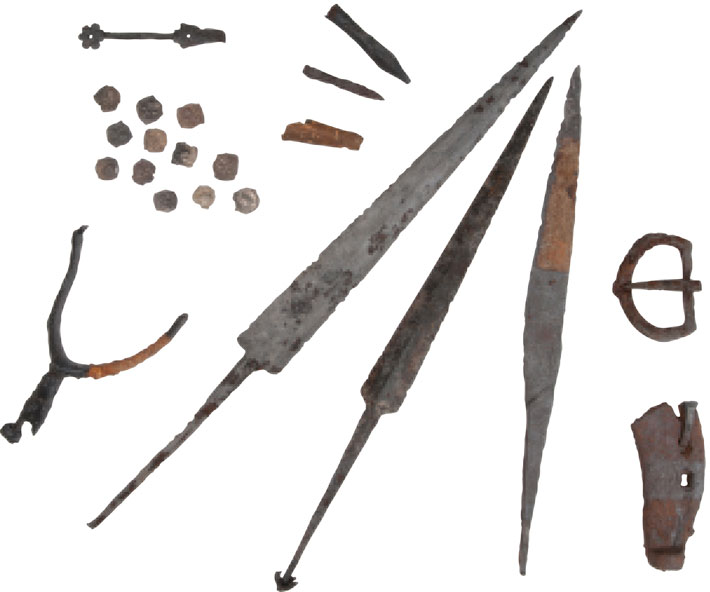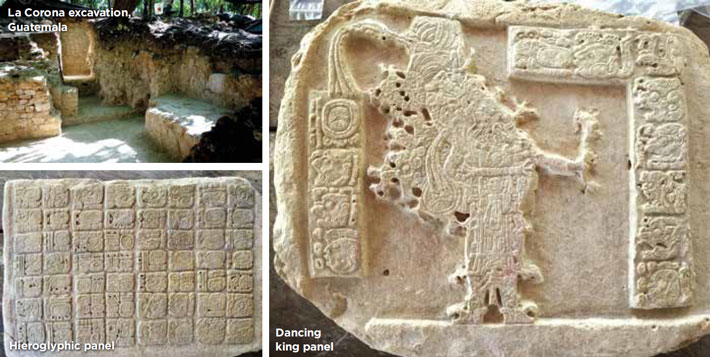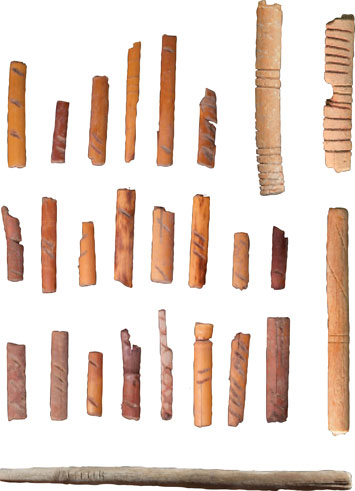From the Trenches
Switzerland Everlasting
By SAMIR S. PATEL
Monday, October 05, 2015
 While neutrality has long been a hallmark of Swiss identity, that wasn’t always the case. In 1315, Duke Leopold of Hapsburg set out to consolidate his power within the Holy Roman Empire and marched into areas controlled by the Swiss Confederacy—then a local alliance. According to historical sources, the more experienced, better-equipped Hapsburg knights were ambushed by Swiss soldiers on the shores of Lake Aegeri. “At Morgarten, as the location is called, the foreign forces were stopped and, as the lore goes, badly decimated,” says Stefan Hochuli, an archaeologist with the Swiss Department of the Interior. Hochuli and officials from the cantons of Zug and Schwyz have found evidence, including knives, arrows, and a spur, that may pinpoint the location of the Battle of Morgarten. The decisive, brutal victory is considered a foundational moment for Switzerland, as it strengthened the Everlasting League, the nucleus of the confederacy.
While neutrality has long been a hallmark of Swiss identity, that wasn’t always the case. In 1315, Duke Leopold of Hapsburg set out to consolidate his power within the Holy Roman Empire and marched into areas controlled by the Swiss Confederacy—then a local alliance. According to historical sources, the more experienced, better-equipped Hapsburg knights were ambushed by Swiss soldiers on the shores of Lake Aegeri. “At Morgarten, as the location is called, the foreign forces were stopped and, as the lore goes, badly decimated,” says Stefan Hochuli, an archaeologist with the Swiss Department of the Interior. Hochuli and officials from the cantons of Zug and Schwyz have found evidence, including knives, arrows, and a spur, that may pinpoint the location of the Battle of Morgarten. The decisive, brutal victory is considered a foundational moment for Switzerland, as it strengthened the Everlasting League, the nucleus of the confederacy.
Premature Aging
By DANIEL WEISS
Monday, October 05, 2015
 The use of radiocarbon dating, which allows archaeologists to estimate the age of human, plant, and animal remains, may soon be complicated by fossil fuel emissions. The technique works because carbon, a key component of living things, exists in radioactive and nonradioactive forms. Radioactive carbon decays at a known rate, so researchers can estimate a specimen’s age based on the portion of its carbon that is still radioactive. Fossil fuels are millions of years old and contain no radioactive carbon, so the more of them burn, the lower the proportion of radioactive carbon in the atmosphere and, in turn, in contemporary organic materials. Nuclear weapons testing increased the amount of radioactive carbon in circulation, but fossil fuel emissions have almost completely countered this effect.
The use of radiocarbon dating, which allows archaeologists to estimate the age of human, plant, and animal remains, may soon be complicated by fossil fuel emissions. The technique works because carbon, a key component of living things, exists in radioactive and nonradioactive forms. Radioactive carbon decays at a known rate, so researchers can estimate a specimen’s age based on the portion of its carbon that is still radioactive. Fossil fuels are millions of years old and contain no radioactive carbon, so the more of them burn, the lower the proportion of radioactive carbon in the atmosphere and, in turn, in contemporary organic materials. Nuclear weapons testing increased the amount of radioactive carbon in circulation, but fossil fuel emissions have almost completely countered this effect.
Heather Graven, a climate physicist at Imperial College London, has modeled the potential impact. “In the business-as-usual scenario where fossil fuel emissions are increasing strongly over the century,” she says, “by 2050, the atmosphere could have the same radiocarbon date as a sample that’s about a thousand years old.” In other words, to future archaeologists, a brand-new garment made in 2050 would have the same proportion of radioactive carbon—and therefore the same radiocarbon date—as one worn by a combatant in the Battle of Hastings, in 1066.
The Magnetism of the Iron Age
By SAMIR S. PATEL
Monday, October 05, 2015
 The Earth’s magnetic field helps protect the planet’s surface from the solar wind and cosmic rays. It’s not a static barrier, but rather a complex system generated by iron flowing in the Earth’s outer core. Every few hundred thousand years, the north and south magnetic poles “flip” position, and for the last 160 years, the magnetic field has been weakening. The causes of the reversals and weakening are unknown, but scientists are finding clues in the charred remains of Iron Age houses in southern Africa.
The Earth’s magnetic field helps protect the planet’s surface from the solar wind and cosmic rays. It’s not a static barrier, but rather a complex system generated by iron flowing in the Earth’s outer core. Every few hundred thousand years, the north and south magnetic poles “flip” position, and for the last 160 years, the magnetic field has been weakening. The causes of the reversals and weakening are unknown, but scientists are finding clues in the charred remains of Iron Age houses in southern Africa.
During the Iron Age, people there would, perhaps because of a bad harvest, ritually “cleanse” their villages by burning them down. The fires burned hot enough to melt magnetic materials in the clay. When those materials cooled and solidified, they were remagnetized by the magnetic field, recording its intensity and direction at that moment.
Southern Africa lies within the South Atlantic Anomaly, a particularly weak patch in the magnetic field, larger than the United States. If it grows large enough, according to University of Rochester geophysicist John Tarduno, it could trigger a reversal of the poles. Understanding how the magnetic field, especially in southern Africa, has changed over time might help scientists better comprehend these processes, since there has not been much good historical data on the southern magnetic field. Because of Iron Age superstition, Tarduno and his colleagues now have a record of the anomaly for between 1,600 and 1,000 years ago.
The findings show that during the Iron Age, the magnetic field was as it is today: weakening, with a big southern dent. The field has recovered to a degree since then, but is now weakening again. This suggests that there is some recurring disruption in the flow of the outer core that, like an eddy in a stream, comes and goes. If that eddy grows large enough, Tarduno says, a reversal might be imminent. Such a reversal could take thousands of years to be completed, and while the Earth would have some magnetic protection during this time, satellite communications, the ozone layer, and our power infrastructure would all be at some risk.
Rituals of Maya Kingship
By ZACH ZORICH
Monday, October 05, 2015
 Two hieroglyphic panels found at the ancient Maya city of La Corona in Guatemala are providing new details about the history of the site’s rulers. One panel shows a dancing king from the city of Calakmul, who ruled in the late ninth century A.D. and probably served as overlord of La Corona. A second panel of hieroglyphic writing tells the story of a king of La Corona named “Red Turkey,” the permissions he had to receive, and the rituals he had to perform to earn his crown. Project director Marcello Canuto of Tulane University says, “It’s a luxury of detail regarding the accession to the throne.”
Two hieroglyphic panels found at the ancient Maya city of La Corona in Guatemala are providing new details about the history of the site’s rulers. One panel shows a dancing king from the city of Calakmul, who ruled in the late ninth century A.D. and probably served as overlord of La Corona. A second panel of hieroglyphic writing tells the story of a king of La Corona named “Red Turkey,” the permissions he had to receive, and the rituals he had to perform to earn his crown. Project director Marcello Canuto of Tulane University says, “It’s a luxury of detail regarding the accession to the throne.”
Game of Diplomacy
By ERIC A. POWELL
Monday, October 05, 2015
 In the thirteenth century A.D., people living in a cave near Utah’s Great Salt Lake spent their free time playing games. Excavations there, led by University of Alberta archaeologist John Ives, have unearthed some 1,300 gaming and gambling pieces, including dice made from split cane. Ives believes the avid gamers were Apache and Navajo ancestors who spent one or two generations in the cave during a long migration to the American Southwest from subarctic Canada. It was a turbulent time, with environmental and social changes roiling the continent, and games may have been helpful in dealing with unfamiliar and potentially hostile neighbors. “Playing games can be a way of negotiating new relationships,” says Ives, “particularly between people who may not have spoken the same language.”
In the thirteenth century A.D., people living in a cave near Utah’s Great Salt Lake spent their free time playing games. Excavations there, led by University of Alberta archaeologist John Ives, have unearthed some 1,300 gaming and gambling pieces, including dice made from split cane. Ives believes the avid gamers were Apache and Navajo ancestors who spent one or two generations in the cave during a long migration to the American Southwest from subarctic Canada. It was a turbulent time, with environmental and social changes roiling the continent, and games may have been helpful in dealing with unfamiliar and potentially hostile neighbors. “Playing games can be a way of negotiating new relationships,” says Ives, “particularly between people who may not have spoken the same language.”
Advertisement
Advertisement
IN THIS ISSUE
From the Trenches
The Second Americans?
Off the Grid
How Much Water Reached Rome?
Paleo-Dentistry
Friars' Leather Shop
The Gates of Gath
Slinky Nordic Treasures
Lake George's Unfinished Fort
Last Flight of a Tuskegee Airman
Mysterious Golden Sacrifice
Aftermath of War
Game of Diplomacy
The Magnetism of the Iron Age
Rituals of Maya Kingship
Premature Aging
Switzerland Everlasting
Advertisement

Recent Issues
-
 May/June 2024
May/June 2024
-
 March/April 2024
March/April 2024
-
 January/February 2024
January/February 2024
-
 November/December 2023
November/December 2023
-
 September/October 2023
September/October 2023
-
 July/August 2023
July/August 2023
-
 May/June 2023
May/June 2023
-
 March/April 2023
March/April 2023
-
 January/February 2023
January/February 2023
-
 November/December 2022
November/December 2022
-
 September/October 2022
September/October 2022
-
 July/August 2022
July/August 2022
-
 May/June 2022
May/June 2022
-
 March/April 2022
March/April 2022
-
 January/February 2022
January/February 2022
-
 November/December 2021
November/December 2021
-
 September/October 2021
September/October 2021
-
 July/August 2021
July/August 2021
-
 May/June 2021
May/June 2021
-
 March/April 2021
March/April 2021
-
 January/February 2021
January/February 2021
-
 November/December 2020
November/December 2020
-
 September/October 2020
September/October 2020
-
 July/August 2020
July/August 2020
-
 May/June 2020
May/June 2020
-
 March/April 2020
March/April 2020
-
 January/February 2020
January/February 2020
-
 November/December 2019
November/December 2019
-
 September/October 2019
September/October 2019
-
 July/August 2019
July/August 2019
-
 May/June 2019
May/June 2019
-
 March/April 2019
March/April 2019
-
 January/February 2019
January/February 2019
-
 November/December 2018
November/December 2018
-
 September/October 2018
September/October 2018
-
 July/August 2018
July/August 2018
-
 May/June 2018
May/June 2018
-
 March/April 2018
March/April 2018
-
 January/February 2018
January/February 2018
-
 November/December 2017
November/December 2017
-
 September/October 2017
September/October 2017
-
 July/August 2017
July/August 2017
-
 May/June 2017
May/June 2017
-
 March/April 2017
March/April 2017
-
 January/February 2017
January/February 2017
-
 November/December 2016
November/December 2016
-
 September/October 2016
September/October 2016
-
 July/August 2016
July/August 2016
-
 May/June 2016
May/June 2016
-
 March/April 2016
March/April 2016
-
 January/February 2016
January/February 2016
-
 November/December 2015
November/December 2015
-
 September/October 2015
September/October 2015
-
 July/August 2015
July/August 2015
-
 May/June 2015
May/June 2015
-
 March/April 2015
March/April 2015
-
 January/February 2015
January/February 2015
-
 November/December 2014
November/December 2014
-
 September/October 2014
September/October 2014
-
 July/August 2014
July/August 2014
-
 May/June 2014
May/June 2014
-
 March/April 2014
March/April 2014
-
 January/February 2014
January/February 2014
-
 November/December 2013
November/December 2013
-
 September/October 2013
September/October 2013
-
 July/August 2013
July/August 2013
-
 May/June 2013
May/June 2013
-
 March/April 2013
March/April 2013
-
 January/February 2013
January/February 2013
-
 November/December 2012
November/December 2012
-
 September/October 2012
September/October 2012
-
 July/August 2012
July/August 2012
-
 May/June 2012
May/June 2012
-
 March/April 2012
March/April 2012
-
 January/February 2012
January/February 2012
-
 November/December 2011
November/December 2011
-
 September/October 2011
September/October 2011
-
 July/August 2011
July/August 2011
-
 May/June 2011
May/June 2011
-
 March/April 2011
March/April 2011
-
 January/February 2011
January/February 2011
Advertisement






